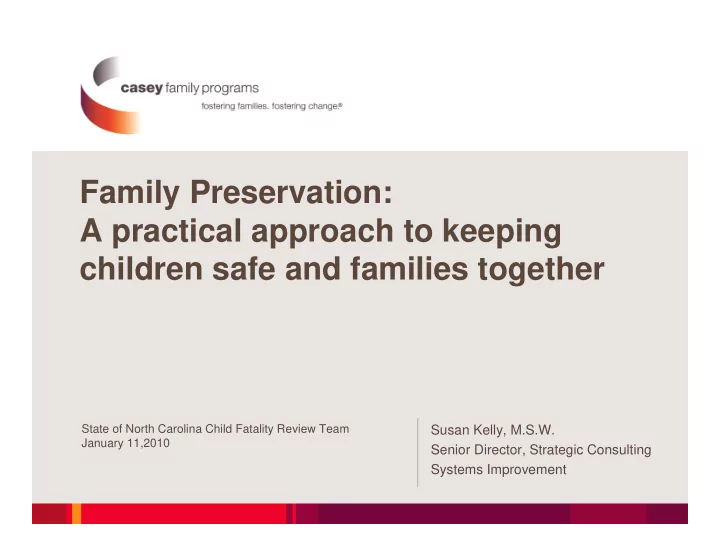

Family Preservation: A practical approach to keeping children safe and families together State of North Carolina Child Fatality Review Team Susan Kelly, M.S.W. January 11,2010 Senior Director, Strategic Consulting Systems Improvement
Casey Family Programs • Seattle Washington • Largest Operating foundation dedicated solely to foster care (improving it , safely reducing it, and eventually eliminating the need for foster care).
GOAL OF CASEY FAMILY PROGRAMS: “Give every child in America the same chance to live their dreams that we give our own children. We call that the standard of our own .” William Bell, President and CEO Gary Severson, Chair, Board of Trustees Casey Family Programs
CASEY’S 2020 STRATEGY • Safely reduce the number of children on foster care by 50 percent by the year 2020.
2020 STRATEGY � Safely reduce the number of children in foster care � Reinvest the money saved � Ensure that all children in foster care have improved well being as well as improved education, employment and mental health outcomes � Reduce disproportionality and disparities in child welfare in support of 2020 goals
IF NOTHING CHANGES BETWEEN NOW AND 2020? � More than 300,000 youth will age out of foster care without a permanent family and into a world where they have little or no support to build a secure and stable adult life. � UNICEF ranks the U.S. 20 out of 21 industrialized nations in basic measures of well-being for its children.
How do we measure outcomes? We measure outcomes on: � SAFETY � Safe Reduction of foster care � Reinvestment of resources in the front end � Self sufficiency, permanency,stability and well being � Race equity(justice and fairness)
WHY FAMILY PRESERVATION? “Child welfare built on a faulty premise that we can wait….We can wait until a crisis has occurred” D. Sanders But should we wait for the following to occur: � Neglect � Abuse � Delinquent behavior � Substance use � Domestic violence ….or should we prevent the maltreatment before it occurs whenever possible?
OUR CHILDREN CANNOT WAIT “ ����������������������������������������������� ���������������������������������������������� ����������������������������������������� ����������������������������� ����������������
What is family preservation? Values informed and evidence informed: Values and beliefs • CHILDREN HAVE A RIGHT TO THEIR FAMILY. • THE FAMILY IS THE FUNDAMENTAL RESOURCE FOR THE NURTURING OF CHILDREN. • IT IS IN THE BEST INTEREST OF THE CHILD FOR HIS OR HER FAMILY TO REMAIN INTACT IN THE ABSENCE OF COMPELLING EVIDENCE TO THE CONTRARY
Values and beliefs (cont.) • FAMILIES ARE OUR COLLEAGUES • FAMILIES CAN CHANGE WITH SUPPORT • WE RESPECT AND WORK WITH OUR CLIENT’S VALUES AND BELIEFS (RACE, ETHNICITY, CULTURE, SPIRITUALITY, COMMUNITIES). • IT IS OUR JOB TO INSTILL HOPE . • A CRISIS IS AN OPPORTUNITY FOR CHANGE.
PROGRAM CHARACTERISTICS • SMALL CASELOADS • INTENSIVE • FLEXIBLE • 24/7 (When convenient for families to meet) • HARD SERVICES (concrete support) • STRENGTH BASED, SOLUTION FOCUSED PRACTICE strategies • TIME LIMITED • FAMILY DRIVEN
Program Characteristics • Focus on and build upon family strengths • Focus on children at imminent risk of removal • Partner with families to remove risks, enhance safety • Immediate response of caseworkers(within 24 hours) • Time limited (4 to 6 weeks of intense support) • Less intensive follow up support • Goal oriented(safety) • Hard and soft services • Ecological approach (work with whole family)
Changing the Dialogue � How to create safety in families, homes, communities � Providing at least as much support to birth families as we do substitute caregivers. � Listen to what families and youth tell us about staying with their families especially siblings
Children’s perception of foster care* • 40% don’t know why they entered care • 90% changed schools and neighborhoods • 25% experienced at lease 3 schools • 50% saw their mothers less than once or twice a month • I in 7 who had siblings did not see them • 90% miss birth family • 80% will return to birth family * Chapin Hall : Foster Care Placement: The Child’s Perspective, 1989
Parents are the first and best teachers. • M.I.T. and University of Minnesota studies that show that foster care children fared worse than comparably maltreated children who received IFPS or in some cases no services • Casey Northwest Alumni Study:1 in 5 foster care alumni does well in later life
The Human Cost? • The predictor of placement is placement • HOPE • To build a standard of services that we would use for our own children and grandchildren….
www.casey.org
Recommend
More recommend